Definition, Illustration, Formulas, Solved Example Problems - Complex Numbers | 12th Mathematics : UNIT 2 : Complex Numbers
Chapter: 12th Mathematics : UNIT 2 : Complex Numbers
Complex Numbers
Complex Numbers
We have seen that the equation x2 +1 = 0 does not have a
solution in real number system.
In general there are polynomial equations with real coefficient
which have no real solution.
We enlarge the real number system so as to accommodate solutions
of such polynomial equations.
This has triggered the mathematicians to define complex number
system.
In this section, we define
a)
Complex numbers in rectangular form
b)
Argand plane
c)
Algebraic operations on complex numbers
The complex number system is an extension of real number system
with imaginary unit i .
The imaginary unit i with the property i2 = ŌłÆ1 , is combined with two
real numbers x and y by the process of addition and multiplication,
we obtain a complex number x + iy. The symbol '+ ' is treated as vector addition. It was introduced by Carl
Friedrich Gauss (1777-1855).
1. Rectangular form
Definition 2.1
(Rectangular form of a complex number)
A complex number is of
the form x + iy (or x + yi) , where x and y are real numbers. x is called the real
part and y
is called the
imaginary part of the complex number.
If x =
0 , the complex number is said to be purely imaginary. If y = 0 , the complex number
is said to be real. Zero is the only number which is at once real and purely
imaginary. It is customary to denote the standard rectangular form of a complex
number x +
iy as z and we write x =
Re(z) and y = Im(z) . For instance, Re(5 ŌłÆ i7) = 5 and Im (5 ŌłÆ i7) = ŌłÆ7 .
The numbers of the form ╬▒ +
i╬▓ , ╬▓ ŌēĀ 0 are called imaginary
(non real complex) numbers.
The equality of complex numbers is defined as follows.
Definition 2.2
Two complex numbers z1 = x1 + iy1 and z2 = x2 + iy2 are said to be equal
if and only if
Re(z1 ) = Re(z2 ) and Im(z1 ) = Im(z2) . That is x1 = x2 and y1 = y2 .
For instance, if ╬▒ +
i╬▓ = ŌłÆ7 + 3i , then ╬▒ = ŌłÆ7 and ╬▓ = 3 .
2. Argand plane
A complex number z =
x + iy is uniquely
determined by an ordered pair of real numbers ( x, y ) .
The numbers 3 ŌłÆ 8i, 6 and ŌłÆ4i are equivalent to (3, ŌłÆ8), (6, 0), and (0, ŌłÆ4) respectively. In this way we are able to associate a complex
number z = x + iy with a point ( x, y ) in a coordinate plane.
If we consider x axis as real axis and y axis as
imaginary axis to represent a complex number, then the xy -plane is
called complex plane or Argand plane. It is named after the Swiss mathematician
Jean Argand (1768 ŌĆō 1822).
A complex number is represented not only by a point, but also by
a position vector pointing from the origin to the point. The number, the point,
and the vector will all be denoted by the same letter z . As usual we
identify all vectors which can be obtained from each other by parallel
displacements. In this chapter, C denotes the set of all complex
numbers. Geometrically, a complex number can be viewed as either a point in R2 or a vector in the
Argand plane.
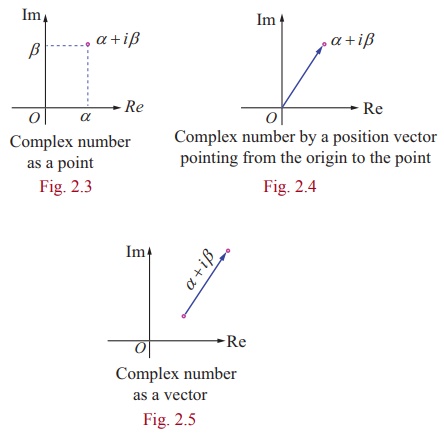
Illustration 2.1
Here are some complex numbers: 2 + i, ŌłÆ 1 + 2i, 3 -
2 i, 0 - 2 i, 3+ ŌłÜ-2, -2-3i, cos (ŽĆ/6) + isin(ŽĆ/6) and
3 + 0i. Some of them are plotted in Argand plane.
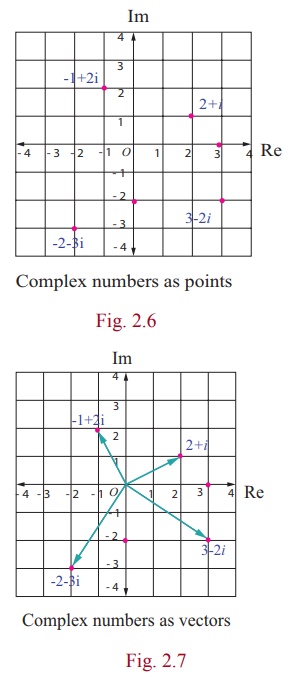
3. Algebraic operations on complex numbers
In this section, we study the algebraic and geometric structure of
the complex number system.
We assume various corresponding properties of real numbers to be
known.
(i) Scalar multiplication of complex numbers:
If z = x + iy and k Ōłł
R, then we define
k z =
(kx) + (ky )i .
In particular 0 z =
0 , 1 z =
z and (ŌłÆ1)z = ŌłÆz .

(ii) Addition of complex numbers:
If z1 = x1 + iy1 and z2 = x2 + iy2 , where x1 , x2 , y1 , and y2 Ōłł
R, then we define
z1 + z2 = (x1 + iy1) + (x2 + iy2)
= (x1 + x2) + i(y1 + y2)
z1 + z2= (x1 + x2) + i(y1 + y2)
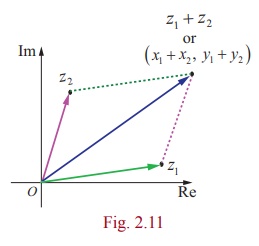
We have already seen that vectors are characterized by length and
direction, and that a given vector remains unchanged under translation.
When z1 = x1 + iy1 and z2 = x2 + iy2 then by the
parallelogram law of
addition,thesum z1 + z2 = ( x1 + x2 ) + i ( y1 + y2 ) corresponds to the point ( x1 + x2 , y1 + y2 ) . It also corresponds to a vector with those coordinates
as its components. Hence the points z1 , z2 , and z1 + z2 in complex plane may
be obtained vectorially as shown in the adjacent Fig. 2.11.
iii) Subtraction of complex numbers
Similarly the difference z1 ŌłÆ z2 can also be drawn as
a position vector whose initial point is the origin and terminal point is ( x1 ŌłÆ x2 , y1 ŌłÆ y2 ) . We define
z1 - z2 = z1 + (- z2 )
= (x1 + iy1) + (-x2 - iy2)
= (x1 - x2) + i(y1 - y2)
z1 + z2= (x1 - x2) + i(y1 - y2)
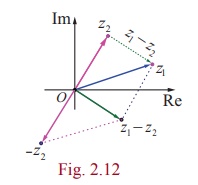
It is important to note here that the vector representing the
difference of the vector z1 ŌłÆ
z2 may also be drawn
joining the end point of z2 to the tip of z1 instead of the origin.
This kind of representation does not alter the meaning or interpretation of the
difference operator. The difference vector joining the tips of z1 and z2 is shown in (green)
dotted line.
(iv) Multiplication of complex numbers
The multiplication of complex numbers z1 and z2 is
defined as
z1 z2 = (x1 + iy1 )(x2 + iy2 )
= (x1 x2 ŌłÆ y1 y2 ) + i(x1 y2 + x2 y1 )
z1 z2 = (x1 x2 ŌłÆ y1 y2 ) + i(x1 y2 + x2 y1 ) .
Although the product of two complex numbers z1 and z2 is itself a complex number represented by a vector, that vector lies in the same plane as the vectors z1 and z2 . Evidently, then, this product is neither the scalar product nor the vector product used in vector algebra.
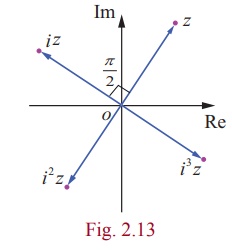
Remark
Multiplication of complex number z by i
If z = x + iy , then
iz = i(x + iy)
= ŌłÆ y + ix
The complex number iz is a rotation of z by 90╦Ü or ŽĆ/2 radians in the counter clockwise direction about the origin. In general, multiplication of a complex number z by i successively gives a 90┬░ counter clockwise rotation successively about the origin.
Illustration 2.2
Let z1 = 6 + 7i and z2 = 3 ŌłÆ 5i . Then z1 + z2 and z1 ŌłÆ z2 are
(i) (3 - 5i) +
(6 + 7i) = (3 + 6) + (-5+7)i = 9+2i
(6 + 7i) - (3 -
5i) = (6 - 3) + (7 - (-5))i = 3+12i
Let z1 = 2 + 3i and z2 = 4 + 7i . Then z1 z2 is
(ii) (2 + 3i)( 4 + 7i) = (2x4 ŌĆō
3x7) + i(2x7 + 3x4)
= (8-21) + (14+12)i
= -13 +26i
Example 2.2
Find the value of the real numbers x and y, if the
complex number (2 +
i)x +
(1ŌłÆ i) y + 2i ŌłÆ 3 and x + (ŌłÆ1+ 2i) y +1+ i are equal
Solution
Let z1 = (2 + i)x +
(1- i) y + 2i - 3 = (2x + y - 3) + i (
x - y + 2) and
z2 = x + (-1+ 2i) y +1+ i = ( x -
y +1) + i (2 y +1).
Given that z1 = z2 .
Therefore (2x + y - 3) + i ( x - y
+ 2) = ( x - y +1) + i (2 y +1) .
Equating real and imaginary parts separately, gives
2x + y - 3= x - y +1 ŌćÆ x + 2 y = 4 .
x - y + 2 = 2 y +1 ŌćÆ x - 3y =
-1 .
Solving the above equations, gives
x = 2 and y =
1.
Related Topics